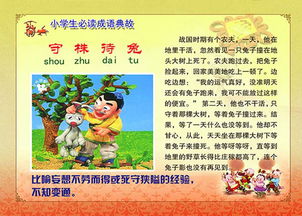守株待兔文言文英文版
Title: Translating the Chinese idiom "守株待兔" to English
Introduction:
"守株待兔" is a wellknown Chinese idiom that has been deeply rooted in Chinese culture for centuries. It is derived from a fable in which a farmer patiently waits by a tree stump, hoping to catch a rabbit that would hit itself against the stump. Translating idioms from one language to another can be challenging due to cultural differences and unique linguistic expressions. In this article, we will explore possible English translations for the idiom "守株待兔" and provide insights into its meaning and usage.
1. Translation options:
1.1 Literal Translation:
The literal translation of "守株待兔" is "guard the stump and wait for the rabbit." While this translation captures the surface meaning, it may not convey the metaphorical implications of the original idiom.

1.2 Waiting for opportunities passively:
One possible translation is "waiting for something to fall into one's lap." This convey the idea of waiting for opportunities or success to come without any proactive efforts.
1.3 Waiting for a windfall:
Another option is "waiting for a windfall." This phrase suggests waiting for unexpected good fortune to strike, without actively seeking or creating opportunities.
2. Meaning and usage:
The idiom "守株待兔" carries the connotation of passively waiting for success or a stroke of luck, rather than taking proactive action. It implies relying solely on chance or external factors without putting in any effort or initiative. The idiom is often used to criticize individuals who adopt a lazy or unproductive attitude, expecting success to come to them effortlessly.
3. Cultural context:
"守株待兔" originated from a Chinese fable about a farmer who happened to witness a rabbit kill itself by dashing into a tree stump. Inspired by this, the farmer decided to wait by the same stump, hoping that more rabbits would do the same. However, this story is not wellknown outside the Chinese culture, making a direct translation inadequate for fully conveying the idiom's cultural nuances.
4. Alternative explanations:
In addition to the passive waiting interpretation, "守株待兔" could also be understood as a cautionary tale about becoming overly complacent or fixated on certain methods, missing out on new opportunities. This alternative interpretation fosters a proactive approach to seek innovation and adaptability.
5. Practical application:
5.1 Business context:
In the corporate world, "守株待兔" warns against relying solely on existing strategies or business models without embracing change or pursuing new opportunities. The idiom reminds businesses to stay agile and innovative in order to thrive in a competitive environment.
5.2 Personal development:
On a personal level, "守株待兔" advises individuals to take a proactive and motivated approach towards achieving their goals. It encourages continuous learning, embracing new challenges, and not expecting success to come simply by waiting.
Conclusion:
The idiom "守株待兔" presents a valuable insight into the mindset of passive waiting for success or luck. It is important to consider the cultural nuances and broader implications when translating idioms. The suggested translations, such as "waiting for something to fall into one's lap" or "waiting for a windfall," aim to capture the essence of the idiom and enable crosscultural understanding. Regardless of the translation, the key takeaway from "守株待兔" is the importance of taking proactive action and seeking opportunities rather than relying solely on chance.
本文 新鼎系統网 原创,转载保留链接!网址:https://acs-product.com/post/9765.html
免责声明:本网站部分内容由用户自行上传,若侵犯了您的权益,请联系我们处理,谢谢!联系QQ:2760375052 版权所有:新鼎系統网沪ICP备2023024866号-15







